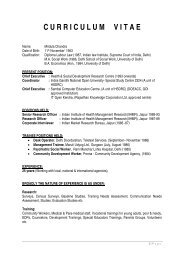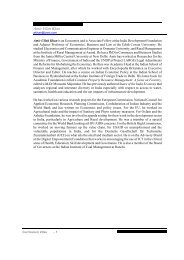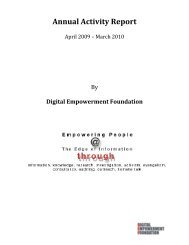ChanderiyaanProjectCS:Layout 1 10/12/2012 5:29 PM Page 4Authors: RAMENDRA SINGH, IIM Calcutta & PRATIk MODI, IRMAExecutive SummaryAccording to Bartel’s (1968) proposition, absence of efficient markets may bedue to one or more of the following market separations: Spatial separation orthe physical distances between producers and consumers; Temporal separationor the time difference between production and consumption; Informationalseparation or the informational asymmetry between producers andconsumers related to products and market conditions; and Financial separationor the lack of consumers’ purchasing power when they are willingness tofulfill their needs. The presence of one or more of the above market separationsoften leads to absence of efficient markets, especially in the bottom ofthe pyramid (BOP).According to Prahalad and Hammond (2002), the bottom of the pyramid (BOP)refers to that part of the untapped markets of the world that has people livingon incomes as low as $2 a day. Constituting the BOP are almost 4 billion peopleliving primarily in Asia, Africa, and South America. In recent years, manymanagement scholars have championed the BOP as a market for firms to sell,or source their products and services from. Prahalad (2005) notes that althoughpoverty alleviation and developmental assistance has been traditionallya domain of the government and its developmental agencies the time has nowcome for the private sector to play a dominant role.Using the context of market development at BOP, we have studied the <strong>Digital</strong><strong>Empowerment</strong> <strong>Foundation</strong>’s Chanderiyaan Project as a case study to understandhow the project has been able to reduce the four market separations todevelop market for Chanderi weavers in Handloom products. We used a casestudy approach to understand DEF’s Chanderiyaan initiative. Our methodologyprimarily involved collecting and analyzing secondary data, followed bysite visit/s to Chanderi, and conducting in-depth interviews of weavers, masterweavers, customers, and employees of DEF, along with non-participantobservations.We find that DEF along with MLA has been successful in reducing market separations,specially those dealing with knowledge and skills enhancement,across all the stages of the supply chain including, sourcing, manufacturing,and retailing. In the larger context, our study throws light on how non-profitorganizations like DEF can create an ecosystem of partnerships with otherNGOs such as Media Lab Asia (MLA), by working closely with Government ofIndia’s Ministry of ICT, weavers, and other stakeholders, for success<strong>full</strong>y developingmarkets at BOP.4From Market Separation to Market Development at Bottom of India’s Socio-Economic PyramidA CAse study on digitAl empowerment FoundAtion’s ChAnderiyAAn projeCt
ChanderiyaanProjectCS:Layout 1 10/12/2012 5:29 PM Page 5According to Prahalad andHammond (2002), the bottomof the pyramid (BOP) refers tothat part of the untappedmarkets of the world that haspeople living on incomes as low as $2 aday. Constituting the BOP are almost 4billion people living primarily in Asia,Africa, and South America. In recentyears, many scholars in managementhave championed the BOP as a marketfor firms to sell, or source their productsand services from. Prahalad (2005)notes that although poverty alleviationand developmental assistance has traditionallybeen the domain of the governmentand its developmentalagencies, the time has now come forprivate sector to play a dominant role.Some scholars do (karnani 2007), however,challenge the basic premise of developingBOP markets by arguing thatthe poor are likely to be exploited bycompanies trying to sell them productsor services that they might not actuallyneed. These critics also argue that tosave the poor from exploitation, giventheir vulnerabilities, the companiesshould preferably treat them as producersand source goods and services fromthem enabling incomes, thereby, andworking towards poverty alleviation.Despite merits on either side of the debateon developing BOP markets, thereare several advantages in treating thepoor as consumers as well as producers.For one thing, the poor have largelyremained absent from the market dueto the paucity of a well-functioning orefficient market. Well-functioning marketsare those in which producers andconsumers interact to success<strong>full</strong>y engagein market exchanges. The poor canbuy/sell at the informal markets of theBOP and participate in formal markets,either as consumers or as producers.Informal markets have already witnessedthe participation of the poorboth as producers and as consumers(De Soto, 2000). In the formal markets,however, the poor are generally absentin both these capacities.. In formal marketsthe BOP producers/consumers areseparated from other producers/consumersdue to several reasons includingremote location and geographicaldispersion of BOP communities, lowand volatile incomes at the BOP, andthe presence of exploitative intermediariesin the BOP. Previous research hasfound that consumers in the BOP typicallyhave low per capita incomes butare large in numbers, which makesthem an attractive market prospect(Prahalad, 2006). Moreover, poor consumers,given their awareness ofbranded goods have developed a highaspiration value for such goods thathold the promise of better quality andare symbols of participation in the market(Prahalad, 2006).Developing BOP markets (in which thepoor participate as consumers) has severalmerits. For one, the current informalmarkets at BOP would give way toa more efficient formal market leadingto a drop in prices, which indirectlyleads to higher disposable income forthe poor and an eventual increase insocial well-being. For example, an MNCpharmaceutical company intending tosell medicines for treating malaria inmalaria-infected African countrieswould benefit the local society there.The incidence of disease in the affectedBOP community would soon diminishcausing, eventually, an overall improvementin the healthcare status and socialwell-being of BOP individuals.. ThisMNC could build economies of scale toreduce prices and develop a large marketacross disparate BOP communitiesin Africa. Participation of the poor asproducers in formal markets would leadto income generation, which wouldeventually turn them into participants(consumers) in those very markets.. Themost successful example is that ofIndia’s largest tobacco company, ITC.ITC’s choupal initiative includes twoarms, e-choupal and choupal sagar.From Market Separation to Market Development at Bottom of India’s Socio-Economic PyramidA CAse study on digitAl empowerment FoundAtion’s ChAnderiyAAn projeCt5








